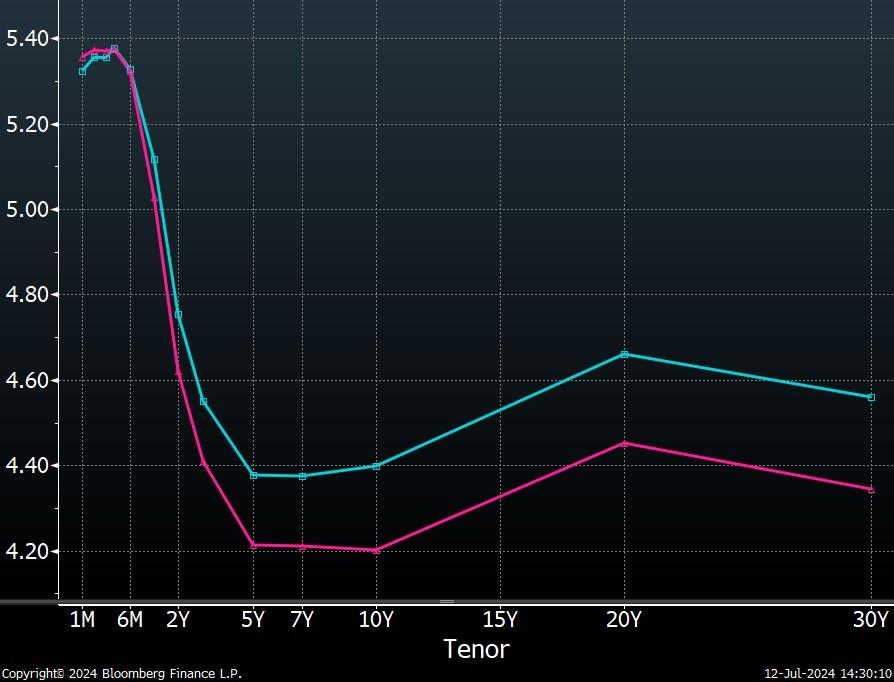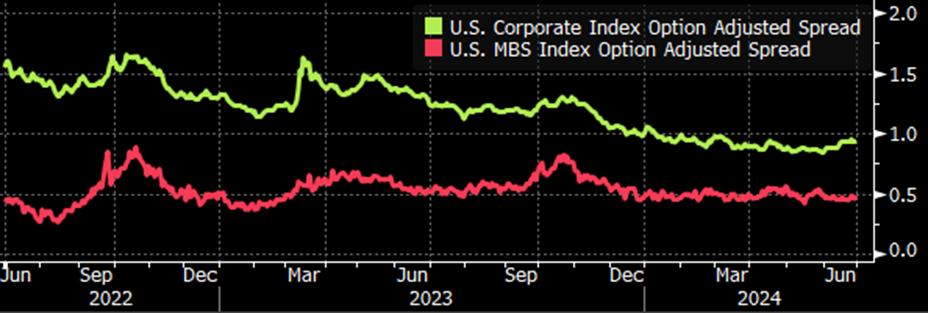

INVESTMENT OUTLOOK



FIXED INCOME: RATE CUTS DELAYED
The U.S. Treasury yield curve rose and steepened during the second quarter, as a generally robust economy convinced bond investors that Federal Reserve (Fed) rate cuts would be delayed until the end of this year. The two-year Treasury yield rose 14 basis points to 4.75% during the quarter, while the 10year Treasury yield was up 20 basis points to 4.40%. Despite this rise the yield curve remained inverted at quarter-end, with the bond market continuing to forecast that high interest rates will eventually slow demand, resulting in subsequent rate cuts. As the second quarter ended, Treasury futures markets indicated that investors expected one or two 25 basis point cuts to the Fed’s key policy rate by year-end, with further cuts in 2025.

U.S. Treasury Yield
Curve
Source: Bloomberg 3/31/24 6/30/24
Source: Bloomberg U.S. Inflation Breakeven Rates

Despite the generally strong U.S. economy, there were indications of slowdown during the second quarter. Consumer spending showed signs of decline, coinciding with a dip in consumer confidence. Additionally, initial jobless claims increased as hiring slowed. Hints of further expected slowdown could be seen in the bond market’s forecast of near-term inflation, with short-term inflation breakeven rates (which are typically correlated with expectations for short-term economic growth) falling during
the second quarter. To be clear, economic data have remained generally robust in recent weeks, but there are signs of a change of momentum for the economy.
Corporate bonds saw their option-
U.S. MBS and Corporate Bond Spreads
Source: Bloomberg

adjusted spreads (OAS) compared to Treasury yields widen in June, resulting in relative underperformance vis-à-vis Treasuries and agency mortgage-backed securities (MBS). We continue to favor agency MBS and Treasuries over corporate bonds, with corporate bond OAS near two-year lows. Corporate bond spreads are negatively correlated with the stock market (a buoyant stock market often results in corporate yield spreads falling and corporate bonds outperforming
other bond classes) and this has been the case during the bull market for stocks during the last two years. We think that a pullback for stocks is overdue, and that this bolsters the chances for agency MBS and Treasuries to outperform corporate bonds in the coming year.
Prepayment risk, the main risk for agency MBS investors, is a minor issue today as the vast majority of the agency MBS universe is trading at a significant discount to par value.
EQUITIES: LARGE-CAP TECHNOLOGY LEADS AGAIN
Stocks were up modestly in the second quarter despite the continuation of high interest rates and some indications of a slowing macroeconomy. The MSCI All Country World Index, a measure of the global stock market, returned 3.0% in the quarter and is up 11.6% year-to-date. Large cap technology stocks led the way again, while energy, industrial, and healthcare stocks
underperformed the market. Small cap and international developed stocks also underperformed.
Broad stock market indices look expensive in the near-term, though there remains good value in certain sectors. The S&P 500, now heavily influenced by largecap technology firms, is trading at 23.2x expected 2024 earnings, which is a hefty valuation given
today’s interest rate environment. The broad market’s high valuation is largely a result of the technology sector’s remarkable run during the last two years (technology stocks now represent 32% of the S&P 500, up considerably from a few years ago). We see better value today in the industrial and healthcare sectors, which are trading closer to historical norms than what is seen
Equity Returns Year-to-Date (Normalized)

Source: Bloomberg
in mega-cap technology stocks.
Regarding the upcoming election in the U.S., the most likely outcome points to divided government, with neither party able to enact drastic changes to the status quo. That said, ongoing developments in the campaign could alter expectations and we will be watching for signs that one party could sweep to power across branches of government. Such an outcome would likely influence sector-specific outlooks and, in all likelihood, corporate profitability
generally. An election sweep could also impact longer-term expectations for inflation given the prospect of ongoing high government deficits (these appear likely given a sweep by either party). Again, a sweep of governmental control is not the base expectation at this time, but further evaluation will be required as we come closer to November.
- Brandon Fitzpatrick, CFA

THIS PUBLICATION IS FOR INFORMATIONAL PURPOSES ONLY. THIS PUBLICATION IS IN NO WAY A SOLICITATION OR OFFER TO SELL SECURITIES OR INVESTMENT ADVISORY SERVICES, EXCEPT WHERE APPLICABLE, IN STATES WHERE DB FITZPATRICK IS REGISTERED OR WHERE AN EXEMPTION OR EXCLUSION FROM SUCH REGISTRATION EXISTS.
INFORMATION THROUGHOUT THIS PUBLICATION, WHETHER STOCK QUOTES, CHARTS, ARTICLES, OR ANY OTHER STATEMENT OR STATEMENTS REGARDING MARKET OR OTHER FINANCIAL INFORMATION, IS OBTAINED FROM SOURCES WHICH WE AND OUR SUPPLIERS BELIEVE RELIABLE, BUT WE DO NOT WARRANT OR GUARANTEE THE TIMELINESS OR ACCURACY OF THIS INFORMATION. BLOOMBERG FINANCE L.P. IS THE SOURCE UTILIZED FOR GRAPHS THROUGHOUT THIS PUBLICATION. THE GRAPHS ARE USED WITH PERMISSION OF BLOOMBERG FINANCE L.P. NEITHER WE NOR OUR INFORMATION PROVIDERS SHALL BE LIABLE FOR ANY ERRORS OR INACCURACIES, REGARDLESS OF CAUSE, OR THE LACK OF TIMELINESS OF, OR FOR ANY DELAY OR INTERRUPTION IN THE TRANSMISSION THEREOF TO THE USER. THERE ARE NO WARRANTIES, EXPRESSED OR IMPLIED, AS TO ACCURACY, COMPLETENESS, OR RESULTS OBTAINED FROM ANY INFORMATION CONTAINED IN THIS PUBLICATION.
NOTHING IN THIS PUBLICATION SHOULD BE INTERPRETED TO STATE OR IMPLY THAT PAST RESULTS ARE AN INDICATION OF FUTURE PERFORMANCE.

